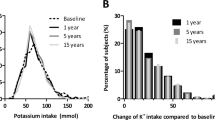Abstract
BACKGROUND: The impact of serum potassium on mortality is inadequately defined.
OBJECTIVE: To determine the association of serum potassium with mortality.
METHODS: We analyzed NHANES I Epidemiological Follow-up Study data from 1974–1992. Of 2,992 subjects with baseline serum potassium, 156 were excluded because their vital status was not known. A total of 2,836 subjects with serum potassium within 2.7–5.4 mmol/L were studied. All-cause and cardiovascular mortality were assessed controlling for sociodemographic status, smoking, medical history, and clinical characteristics.
RESULTS: At baseline, mean age was 46.6 years, and mean serum potassium was 4.07 mmol/L. Subjects were stratified into three groups by mean ± 1 standard deviation of serum potassium: low, 2.7–3.7 mmol/L (N= 77); middle, 3.8–4.4 mmol/L (N=1,982); and high, 4.5–5.4 mmol/L (N=377). The cardiovascular mortality rate per 1,000 person-years adjusted for age, gender, and race for the high serum potassium group (8.1) was significantly higher than the middle (5.3) and low (6.5) serum potassium groups. Further analysis, controlling for age, gender, race, smoking status, cholesterol, and history of diabetes, renal disease, and cardiovascular disease, revealed that the increased cardiovascular mortality among subjects with moderately increased serum potassium was most prominent in those reporting use of diuretics (hazard ratio, 2.65; 95% confidence interval [95% CI], 1.20 to 5.85) and those with abnormal renal function (hazard ratio, 1.89; 95% CI, 1.05 to 3.41).
CONCLUSION: In this general population sample with mostly normal serum potassium, higher serum potassium was independently associated with increased cardiovascular mortality.
Similar content being viewed by others
References
Gabow PA, Peterson LN. Disorders of potassium metabolism. In: Schrier RW, ed. Renal and Electrolyte Disorders. Boston: Little, Brown & Company; 1986: 231–85.
Young DB. Analysis of long term potassium regulation. Endocr Rev. 1985;6:24–44.
Hyman D, Kaplan NM. The difference between serum and plasma potassium. New Engl J Med. 1985;313:642.
Pannall P, Rossi A. Potassium levels in serum and plasma. Clin Chim Acta. 1970;30:218–20.
Hollifield JW, Slaton PE. Thiazide diuretics, hypokalemia and cardiac arrhythmias. Acta Med Scand. 1981;641(suppl):67–73.
Siscovick DS, Raghunathan TE, Psaty BM, et al. Diuretic therapy for hypertension and risk of primary cardiac death. New Engl J Med. 1994;330:1852–7.
Cohen JD, Neaton JD, Prineas RJ, Daniels KA. Diuretics, serum potassium and ventricular arrhythmias in the multiple risk factor intervention trial. Am J Cardiol. 1987;60:548–54.
Kassirer JP, Harrington JT. Fending off the potassium pushers. New Engl J Med. 1985;312:785–7.
Wannamethee SG, Lever AF, Shaper AG, Whincup PH. Serum potassium, cigarette smoking, and mortality in middle-aged men. Am J Epidemiol. 1997;145:598–606.
Miller HW. Plan and operation of the health and nutrition examination survey, United States, 1971–1973. National Center for Health Statistics. Vital Health Stat 1. 1978;1:1–46.
Miller HW. Plan and operation of the health and nutrition examination survey: United States, 1971–1973. Vital Health Stat 1. 1973;1:1–77.
Engel A, Murphy RS, Maurer K, Collins E. Plan and operation of the NHANES I Augmentation Survey of Adults 25–74 years, United States, 1974–1975. Vital Health Stat 1. 1978;(14):1–110.
Cohen BB, Barbano HE, Cox CS, et al. Plan and operation of the NHANES I Epidemiologic Followup Study: 1982–84. Vital Health Stat 1. 1987;(22):1–142.
Cox CS, Mussolino ME, Rothwell ST, et al. Plan and operation of the NHANES I Epidemiologic Followup Study: 1992. Vital Health Stat 1. 1997;(35):1–231.
McLaughlin JK, Dietz MS, Mehl ES, et al. Reliability of surrogate information on cigarette smoking by type informant. Am J Epidemiol. 1987;126:144–6.
Machlin SR, Kleinman JC, Madans JH. Validity of mortality analysis based on retrospective smoking information. Stat Med. 1989;8:997–1009.
Robertson JWK, Isles CG, Brown I, et al. Mild hypokalemia is not a risk factor in treated hypertensives. J Hypertens. 1986;4:603–8.
Siegel D, Hulley SB, Black DM, et al. Diuretics, serum and intracellular electrolyte levels, and ventricular arrhythmias in hypertensive men. JAMA. 1992;267:1083–9.
Hollifield JW. Potassium and magnesium abnormalities: diuretics and arrhythmias in hypertension. Am J Med. 1984;77:28–32.
Ames RP, Hill P. Elevation of serum lipid levels during treatment with antihypertensive drugs. Am J Med. 1976;61:748–57.
Bengtsson C. Elevated serum uric acid levels during treatment with antihypertensive drugs. Acta Med Scand Suppl. 1979;628:69–71.
Murphy MB, Lewis PJ, Kohner E, Schumer B, Dollery CT. Glucose intolerance in hypertensive patients treated with diuretics: a 14-year follow-up. Lancet. 1982;2:1293–5.
Author information
Authors and Affiliations
Corresponding author
Additional information
The NHANES I Epidemiologic Follow-up Study has been developed and funded by these agencies: National Center for Health Statistics; National Institute on Aging; National Cancer Institute; National Center for Chronic Disease Prevention and Health Promotion; National Institute of Child Health and Human Development; National Heart, Lung, and Blood Institute; National Institute on Alcohol Abuse and Alcoholism; National Institute of Mental Health; National Institute of Diabetes and Digestive and Kidney Disease; National Institute of Arthritis and Musculoskeletal and Skin Disease; National Institute of Allergy and Infectious Disease; National Institute of Neurological and Communicative Disorders and Stroke; and U.S. Department of Agriculture. The field work was conducted by Westat Inc., Gaithersburg, Md.
Rights and permissions
About this article
Cite this article
Fang, J., Madhavan, S., Cohen, H. et al. Serum potassium and cardiovascular mortality. J GEN INTERN MED 15, 885–890 (2000). https://doi.org/10.1046/j.1525-1497.2000.91021.x
Issue Date:
DOI: https://doi.org/10.1046/j.1525-1497.2000.91021.x




